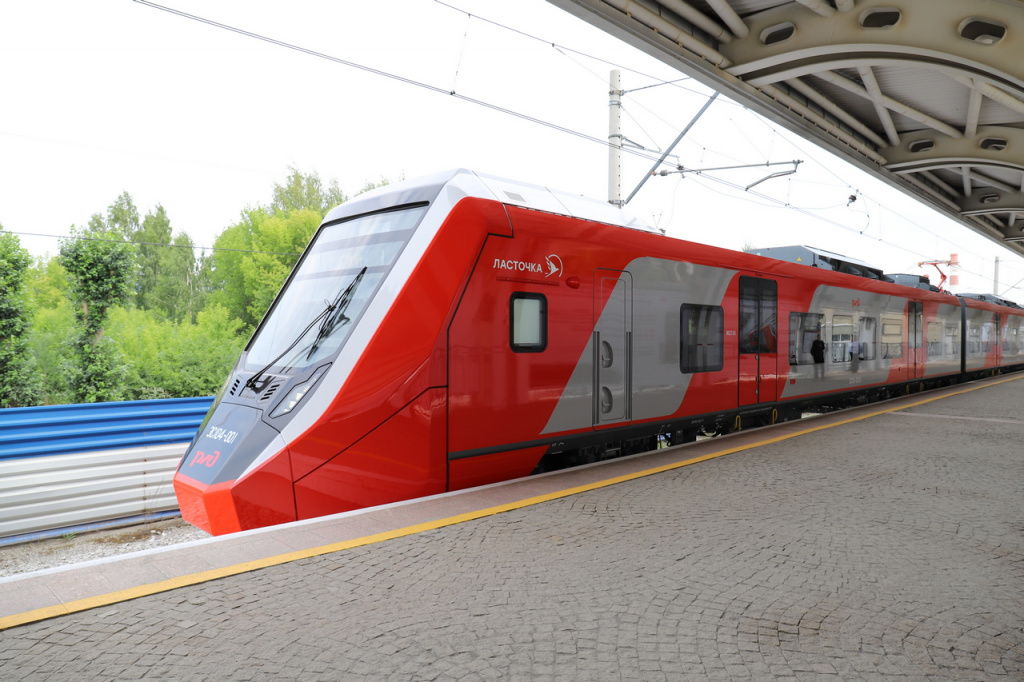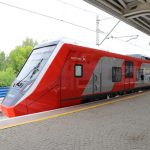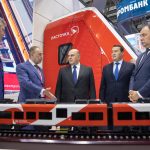 Sinara Transport Machines presented a prototype of the Lastochka ES104 EMU manufactured at the Ural Locomotives plant during the international industrial exhibition of Russia Innoprom-2023 in Ekaterinburg.
Sinara Transport Machines presented a prototype of the Lastochka ES104 EMU manufactured at the Ural Locomotives plant during the international industrial exhibition of Russia Innoprom-2023 in Ekaterinburg.
The President of Sinara Group Mikhail Khodorovsky and company’s General Director Viktor Lesh have unveiled the new EMU in the presence of the Prime Minister of Russia Mikhail Mishustin, and its counterparts of Belarus, Roman Golovchenko, and Kazakhstan, Alikhan Smailov.
Its key advantage will be Russian-made traction equipment capable of providing fast train acceleration of up to 160 km/h and regenerative braking with energy recovery to the grid. In the next two years, the train will become the base platform for a whole line of domestic new generation of electric trains.
The train has improved aerodynamic properties which will reduce the aerodynamic noise by 18% compared to the previous Lastochka ES2G model.
The train provides increased comfort for passengers and has an increased capacity for 416 seats of which 7 folding seats in a five-car configuration compared to the previous version of Lastochka ES2G Standard unit which has 346 cars. In addition, the new EMU provides spacious luggage racks and the opportunity to install bike racks, at operator’s requirements. Passenger seats are equipped with USB sockets for charging mobile devices. The cars are equipped with a system of microclimate and air disinfection and the installed lifts and wheelchair areas are facilitating the access and travel of passengers with reduced mobility.
The Lastochka ES104 EMU in the main composition is made up of 25-meter-long five cars but it can be increased from free to 12 railcars depending on transport demand.
Unlike the previous model, the prototype features the concentration of a functional set of traction equipment on a single motor car (the train’s second car) which is also equipped with traction converter with integrated main filters and its own bogie. The head car of the ES104 train has only the auxiliary converter (PSN), located on the roof. This arrangement of equipment makes it possible to install three motor cars in a 5-car train, providing an increase in the acceleration rate.
The new domestically designed electric multiple unit is equipped with the most advanced technologies and has a new and modern design, compared to the previous versions. The Lastochka ES104 EMU is equipped with rear-view cameras and people counting system as well as with an auto-guidance system.
The new train version has been sent for acceptance and certification tests scheduled to be issued in October 2023. After receiving the certificate, the first 10 trains will be handed over to Russian Railway (RZD) in the first quarter of 2024. The company ordered from Sinara 22 five-car Lastochka ES104 EMUs this spring.
The trains will be tested at the Railway Research Institute (VNIIZHT) and after confirming their safety, the trains will enter testing procedure on the railway routes between Moscow and Vladimir Oblast. The specialists will check the train’s functionality and the way they meet safety standards, travelling at up to 160 km/h.
“Our scientists will conduct a whole range of tests, for example, they will check the operation of the traction drive, control systems, diagnostics, radio communications as well as the dynamic properties of the electric train,” Russian Railways said.
Ural Locomotives plant began to create the new Russian electric train with domestic traction equipment in 2022 and in April 2023 the contract has been signed with RZD to deliver the Lastochka ES104 EMU fleet designed for electric lines.
Under the contract signed between Russian Railways and Trading House STM, the manufacturer will deliver the new electric multiple units in November 2023 which will become a base platform for a whole line of domestic new-generation electric trains. The first trains to be delivered will enter operation on the railway network in Sverdlovsk region, located in the Ural Federal District.
The Lastochka trains, based on Desiro platform, have been manufactured by Ural Locomotives, a joint venture between Sinara Transport Machines and Siemens signed in 2010. The joint venture has been dissolved when Siemens Mobility decided to withdrawal from Russian market as a result of the Ukraine war. In May 2022, the company announced the exit from all its industrial operations and all industrial business activities in Russia. After the start of the war, Siemens put all new business in and international deliveries to Russia and Belarus on hold.
Share on:





